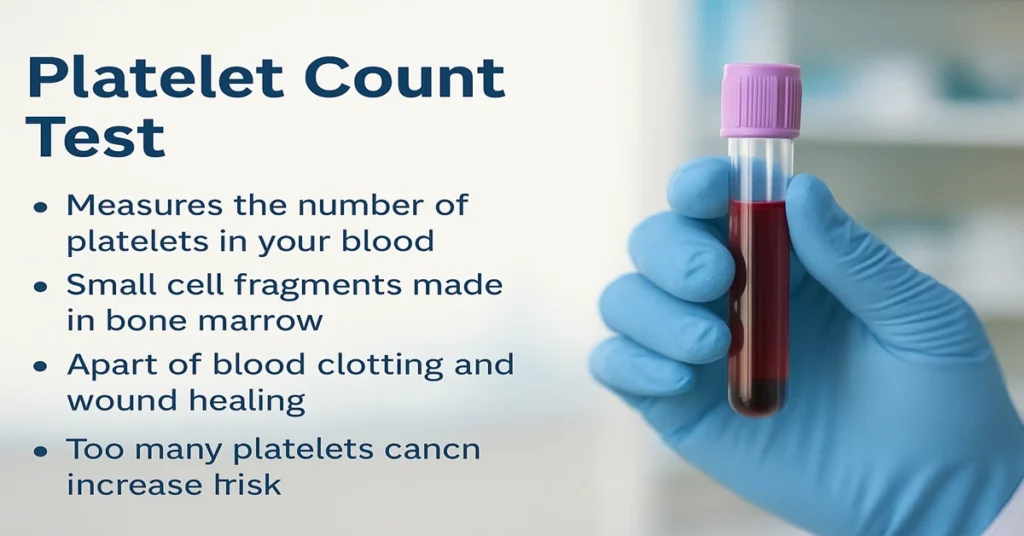What is the Platelet Test?
The Platelet Count Test measures how many platelets are present in your blood. Platelets are tiny, disc-shaped cells that help blood clot and stop bleeding when you get injured. This test is part of the Complete Blood Count (CBC) and is important for diagnosing bleeding disorders, bone marrow problems, or clotting-related conditions.
If platelet count is too low, even a small cut may cause prolonged bleeding. If it is too high, there is a risk of clots, stroke, or heart attack.
Where Are Platelets Synthesized/Produced in the Body?
Platelets are made in the bone marrow. Large cells called megakaryocytes break into fragments, and each fragment becomes a platelet. These platelets then circulate in the bloodstream and play a key role in clotting and wound healing.
Main Functions and Importance of Platelets
- Blood Clotting: Platelets gather at the site of vessel injury and form a plug to stop bleeding.
- Wound Healing: They release chemicals that help tissue repair.
- Maintain Vessel Integrity: Platelets prevent blood vessels from leaking.
Without enough platelets, bleeding may not stop. Too many platelets can increase the risk of dangerous clots.
Causes of Low Platelet Count (Thrombocytopenia)
- Viral Infections: Dengue, hepatitis, HIV
- Autoimmune Disorders: ITP (Immune Thrombocytopenic Purpura), lupus
- Bone Marrow Disorders: Leukemia, aplastic anemia
- Cancer Treatments: Chemotherapy, radiation
- Medications: Certain antibiotics, anti-seizure drugs
- Nutritional Deficiencies: Lack of Vitamin B12 or folate
- Alcohol Abuse
- Enlarged Spleen: Traps and destroys platelets
Symptoms of Low Platelet Count
- Easy bruising
- Frequent nosebleeds or gum bleeding
- Prolonged bleeding from small cuts
- Blood in urine or stool
- Heavy menstrual periods
- Petechiae (tiny red or purple skin spots)
- Fatigue (if bleeding is ongoing)
Causes of High Platelet Count (Thrombocytosis)
- Iron Deficiency Anemia
- Recent surgery or trauma
- Infections or inflammation
- Certain cancers (lung, colon, breast, lymphoma)
- After spleen removal (post-splenectomy)
- Chronic myeloproliferative disorders (e.g., essential thrombocythemia)
Symptoms of High Platelet Count
Most people have no symptoms, but if very high:
- Headache
- Dizziness or light-headedness
- Chest pain
- Numbness or tingling in hands or feet
- Risk of blood clots (stroke, heart attack)
- Redness or burning pain in fingers or toes (rare)
Reference Ranges
(may vary by lab)
- Normal Platelet Count: 150,000 – 450,000 cells/mcL
- Low Platelets (< 150,000/mcL): Risk of bleeding
- High Platelets (> 450,000/mcL): Risk of clotting
Sample Type
- Sample Taken: Whole blood
- Tube Used: Lavender-top EDTA tube
Test Preparation
- No fasting is usually required.
- Stay hydrated before the test.
- Inform your doctor about medications (like blood thinners, chemotherapy drugs, or antibiotics).
- If you have symptoms like frequent bleeding or unexplained bruises, consult your doctor immediately.
When to Consult a Doctor
- If you have unexplained bruising or bleeding.
- If you have heavy periods or bleeding gums.
- If platelet levels are consistently low or high in reports.
- If you have conditions like dengue, hepatitis, cancer, or family history of clotting disorders.
~END~

